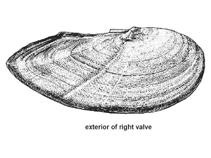Soletellina diphos (Linnaeus, 1771)
Diphos sanguin| Native range | All suitable habitat | Point map | Year 2050 |

|
| This map was computer-generated and has not yet been reviewed. |
| Soletellina diphos AquaMaps Data sources: GBIF OBIS |
Classification / Names Common names | Synonyms | CoL | ITIS | WoRMS
| Cardiida | Psammobiidae
Environment: milieu / climate zone / depth range / distribution range Écologie
; saumâtre; profondeur 0 - 30 m (Ref. 348). Tropical; 35°N - 1°N, 47°E - 141°E
Distribution Pays | Zones FAO | Écosystèmes | Occurrences | Introductions
Indo-West Pacific: from the Persian Gulf to Philippines Islands; north to Korea and Japan, and south to Indonesia. Soletellina diphos.
Length at first maturity / Taille / Poids / Âge
Maturity: Lm ? range ? - ? cm Max length : 12.0 cm SHL mâle / non sexé; (Ref. 348); common length : 8.0 cm SHL mâle / non sexé; (Ref. 348)
Found in an estuary, exposed during low tide (Ref. 106943). Occurs at the low tide mark (Ref. 348). Buries in mud (Ref. 106943).
Life cycle and mating behavior Maturité | Reproduction | Frai | Œufs | Fécondité | Larves
Members of the class Bivalvia are mostly gonochoric, some are protandric hermaphrodites. Life cycle: Embryos develop into free-swimming trocophore larvae, succeeded by the bivalve veliger, resembling a miniature clam.
Référence principale
Références | Coordinateur | Collaborateurs
Poutiers, J.M. 1998. (Ref. 348)
Statut dans la liste rouge de l'IUCN (Ref. 130435)
statut CITES (Ref. 108899)
Not Evaluated
CMS (Ref. 116361)
Not Evaluated
Menace pour l'homme
Harmless
Utilisations par l'homme
Pêcheries: commercial
| FishSource | Sea Around Us
Outils
Plus d'informations
Pays
Zones FAO
Écosystèmes
Occurrences
Introductions
Stocks
Écologie
Régime alimentaire
Éléments du régime alimentaire
Zones FAO
Écosystèmes
Occurrences
Introductions
Stocks
Écologie
Régime alimentaire
Éléments du régime alimentaire
Sources Internet
BHL | BOLD Systems | CISTI | DiscoverLife | FAO(Publication : search) | Fishipedia | GenBank (genome, nucleotide) | GloBI | Gomexsi | Google Books | Google Scholar | Google | PubMed | Arbre de Vie | Wikipedia (Go, chercher) | Zoological Record
Estimates based on models
Preferred temperature
(Ref. 115969): 19.1 - 29.2, mean 28.4 (based on 2689 cells).
Catégorie de prix
(Ref. 80766):
Unknown.
Nutrients: Calcium = 149 [71, 228] mg/100g; Iron = 8.53 [1.95, 15.11] mg/100g; Protein = 9.88 [8.64, 11.12] %; Omega3 = 0.313 [0.202, 0.423] g/100g; Selenium = 61 [50, 72] μg/100g; VitaminA = 0 μg/100g; Zinc = 2.04 [0.56, 3.51] mg/100g (wet weight).



